用友批量修改权限
用友U8用户和权限如何设置
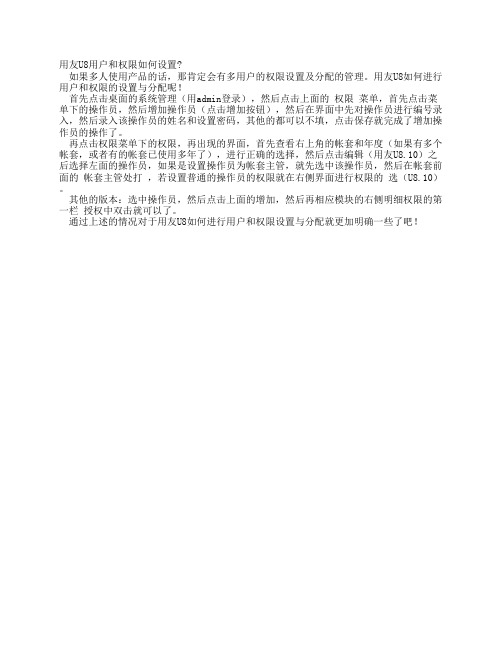
用友U8用户和权限如何设置?
如果多人使用产品的话,那肯定会有多用户的权限设置及分配的管理。
用友U8如何进行用户和权限的设置与分配呢!
首先点击桌面的系统管理(用admin登录),然后点击上面的 权限 菜单,首先点击菜单下的操作员,然后增加操作员(点击增加按钮),然后在界面中先对操作员进行编号录入,然后录入该操作员的姓名和设置密码,其他的都可以不填,点击保存就完成了增加操作员的操作了。
再点击权限菜单下的权限,再出现的界面,首先查看右上角的帐套和年度(如果有多个帐套,或者有的帐套已使用多年了),进行正确的选择,然后点击编辑(用友U8.10)之后选择左面的操作员,如果是设置操作员为帐套主管,就先选中该操作员,然后在帐套前面的 帐套主管处打 ,若设置普通的操作员的权限就在右侧界面进行权限的 选(U8.10)。
其他的版本:选中操作员,然后点击上面的增加,然后再相应模块的右侧明细权限的第一栏 授权中双击就可以了。
通过上述的情况对于用友U8如何进行用户和权限设置与分配就更加明确一些了吧!。
用友NC权限设置教程(官方实用)
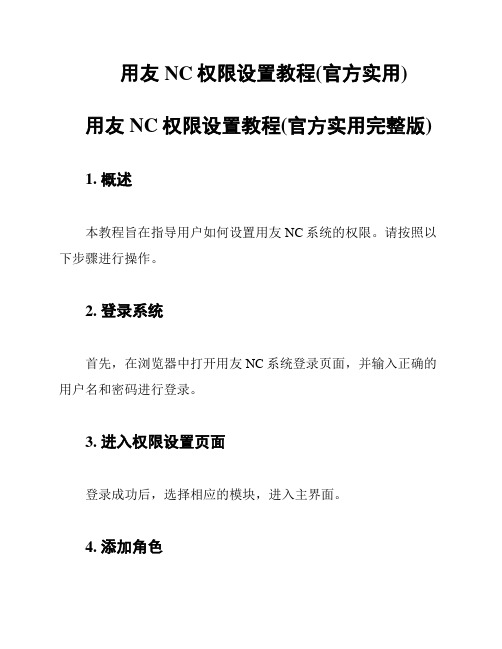
用友NC权限设置教程(官方实用)用友NC权限设置教程(官方实用完整版)
1. 概述
本教程旨在指导用户如何设置用友NC系统的权限。
请按照以下步骤进行操作。
2. 登录系统
首先,在浏览器中打开用友NC系统登录页面,并输入正确的用户名和密码进行登录。
3. 进入权限设置页面
登录成功后,选择相应的模块,进入主界面。
4. 添加角色
在主界面中,找到权限设置菜单,点击进入。
在权限设置页面,点击“添加角色”按钮,填写角色名称和描述,并保存。
5. 分配权限
选择所添加的角色,在权限设置页面中,点击“分配权限”按钮。
根据需要,勾选相应的权限项,并保存。
6. 设置用户角色
在权限设置页面,选择相应的用户,点击“设置角色”按钮。
在弹出的设置角色窗口中,选择需要的角色,并保存。
7. 完成设置
经过以上步骤操作后,用户的权限设置就完成了。
8. 注意事项
- 在设置权限时,请根据具体需求选择相应的权限项。
- 确保分配给用户的角色与其实际职责相符。
- 定期审查和更新权限设置,以保证信息安全和合规性。
以上是用友NC权限设置的教程,希望对您有所帮助。
用友U8数据权限设置
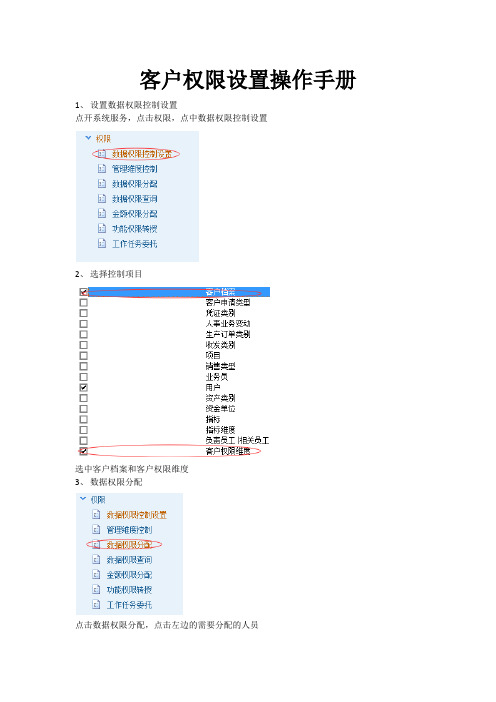
客户权限设置操作手册
1、设置数据权限控制设置
点开系统服务,点击权限,点中数据权限控制设置
2、选择控制项目
选中客户档案和客户权限维度
3、数据权限分配
点击数据权限分配,点击左边的需要分配的人员
右边选择记录中的客户权限维度
上面选择维度档案
维护档案:可以以业务员的名称分类
设置好客户权限维度之后推出该界面,点击上方档案分配
左边选择分类名,上边默认选择分类,右边将可分配内容选择到右边分类里面点击保存会有提示重新登录后生效
退出分配界面选择授权
将各自分类分配给各自人员
退出以上界面
选择维度控制方式权限改为本级
4、设置客户权限
设置销售管理-选项
业务控制中控制客户权限打勾,以上设置全部完成。
用友U890权限设置详解
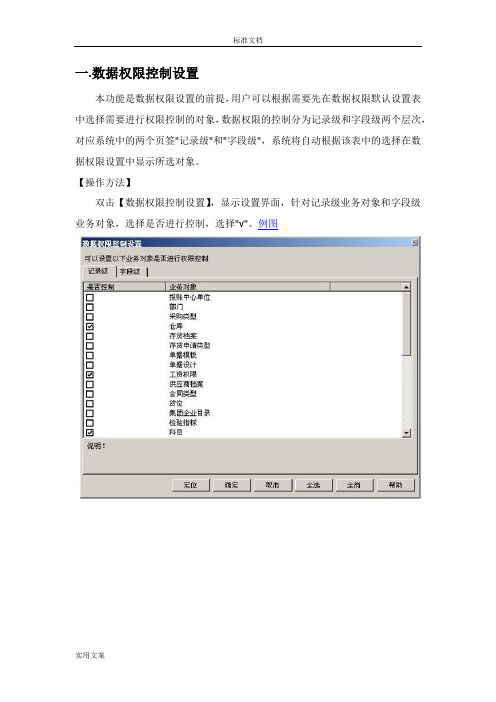
一.数据权限控制设置本功能是数据权限设置的前提,用户可以根据需要先在数据权限默认设置表中选择需要进行权限控制的对象,数据权限的控制分为记录级和字段级两个层次,对应系统中的两个页签"记录级"和"字段级",系统将自动根据该表中的选择在数据权限设置中显示所选对象。
【操作方法】双击【数据权限控制设置】,显示设置界面,针对记录级业务对象和字段级业务对象,选择是否进行控制,选择"√"。
例图提示1.敏感数据权限控制(1)对不同业务对象(如单据、报表、列表、参照等)同一含义的字段统一控制数据权限,以避免用户对每个业务对象都要进行权限设置及分配,提高了字段级权限控制的易用性。
(2)UAP平台提供了[敏感数据维护工具],登录U8UAP进行业务对象的定义及维护;(3)分级定义或维护业务对象的属性;(4)把敏感对象的末级属性与相关业务对象的字段进行映射;(5)登录U8应用平台,打开数据权限控制窗口,选择"字段"页签,选中在UAP定义的业务对象控制权限;(6)打开数据权限设置窗口,选择用户、选择业务对象,通过对业务对象某属性的授权,进而完成了此属性映射字段的授权。
提示:详细说明请参见UAP帮助2.系统预置了3个敏感业务对象:存货、供应商、客户。
3.账套主管不参加数据权限分配。
4.对应每一个业务对象,其权限的控制范围在数据权限默认控制界面和权限设置界面中均有一个简单说明。
5.如果是集团账套,则在数据权限控制设置中增加"集团企业目录"档案的选择。
6."默认权限"列,可以按业务对象设置默认"有权"还是"无权"。
二、数据权限设置必须在系统管理中定义角色或用户,并分配完功能级权限后才能在这里进行"数据权限分配"。
数据级权限分配包括:1.记录权限分配:是指对具体业务对象进行权限分配。
用友T+典型业务-权限设置
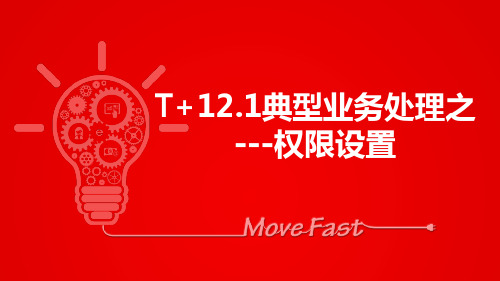
TUFO报表权限怎样设置?
具体业务场景: TUFO有资产负债表、利润表、现金流量表等报表,这些报表怎样授权的呢?
答:通过功能权限进行控制的。
管理可以更简单 工作可以更快乐
场景1:如何区别为独立用户赋权和为用户组赋权
用户组
适合
多个用户即组成一个用户组,用户组可实现快速批量 授权;一个用户不能属于多个用户组,只能属于一个 用户组,或者不属于用户组。
操作员数量较多、有比较明确的岗位定义、需要为岗位 赋权。组内用户会自动拥有该组的功能、字段权限。
独立用户 不从属于任何用户组的用户即为独立用户。
场景4:如何限制成本、金额等敏感信息的查看?
具体业务场景: 对于出入库单据,想要限制仓管员只能查看数量,不能查限-授权-控制字段权限。
特殊说明
分类档案有没有权限控制?
具体业务场景: 存货档案、往来单位档案都可以按照存货分类或往来单位分类授权?
是不是对应分类已经根据授权进行控制了呢?
记录级权限,只能对授权记录进行操作;数据权限是基于档案进 行控制
业务场景描述
业务场景描述
场景1:如何区别为独立用户赋权和为用户组赋权? 场景2:如何管理客户权限?使业务员仅能查看自己有权限的客户? 场景3:如何控制不允许查看和修改他人的单据? 场景4:如何限制成本、金额等敏感信息的查看?
权限设置解决方案
T+12.1典型业务处理之 ---权限设置
名词解释 业务场景描述
权限设置 特殊说明
名词解释
名词解释 权限设置?
分为功能权限、字段权限和数据权限。
如何批量授权用户权限(十)
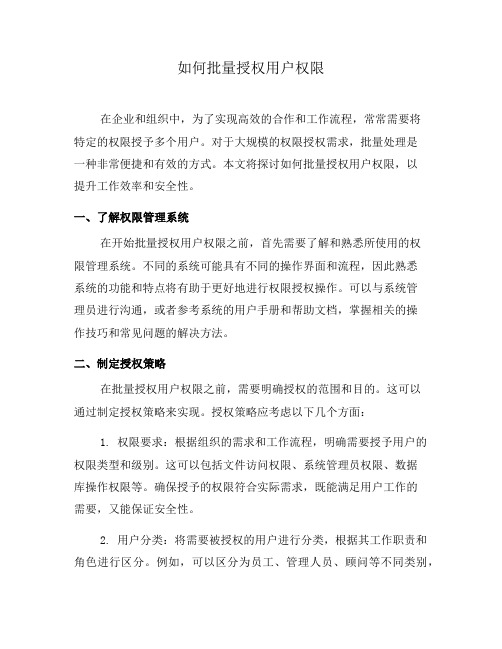
如何批量授权用户权限在企业和组织中,为了实现高效的合作和工作流程,常常需要将特定的权限授予多个用户。
对于大规模的权限授权需求,批量处理是一种非常便捷和有效的方式。
本文将探讨如何批量授权用户权限,以提升工作效率和安全性。
一、了解权限管理系统在开始批量授权用户权限之前,首先需要了解和熟悉所使用的权限管理系统。
不同的系统可能具有不同的操作界面和流程,因此熟悉系统的功能和特点将有助于更好地进行权限授权操作。
可以与系统管理员进行沟通,或者参考系统的用户手册和帮助文档,掌握相关的操作技巧和常见问题的解决方法。
二、制定授权策略在批量授权用户权限之前,需要明确授权的范围和目的。
这可以通过制定授权策略来实现。
授权策略应考虑以下几个方面:1. 权限要求:根据组织的需求和工作流程,明确需要授予用户的权限类型和级别。
这可以包括文件访问权限、系统管理员权限、数据库操作权限等。
确保授予的权限符合实际需求,既能满足用户工作的需要,又能保证安全性。
2. 用户分类:将需要被授权的用户进行分类,根据其工作职责和角色进行区分。
例如,可以区分为员工、管理人员、顾问等不同类别,并为每个类别制定相应的权限设置。
这样可以确保权限授权更加精细化和可控。
3. 授权流程:制定授权的流程和步骤,明确授权的责任人和授权的周期。
可以通过系统内的流程配置或者制定相关的文档和表格来规范授权流程。
这样可以确保权限的授权过程有序和可追溯。
三、批量导入和更新用户信息在批量授权用户权限时,常常需要导入和更新大量用户的信息。
这可以通过系统提供的批量导入功能来实现。
首先,准备一个包含用户信息的数据文件,可以是Excel表格或CSV文件格式。
然后,按照系统的要求,将文件导入到权限管理系统中,并根据需要进行更新或新增用户信息。
在导入用户信息之前,需要确保数据的准确性和完整性。
可以进行数据清洗和去重,以避免重复或错误的信息导入。
另外,还需要关注数据的安全性,确保只有授权人员才能访问和操作用户信息。
用友U9权限管理
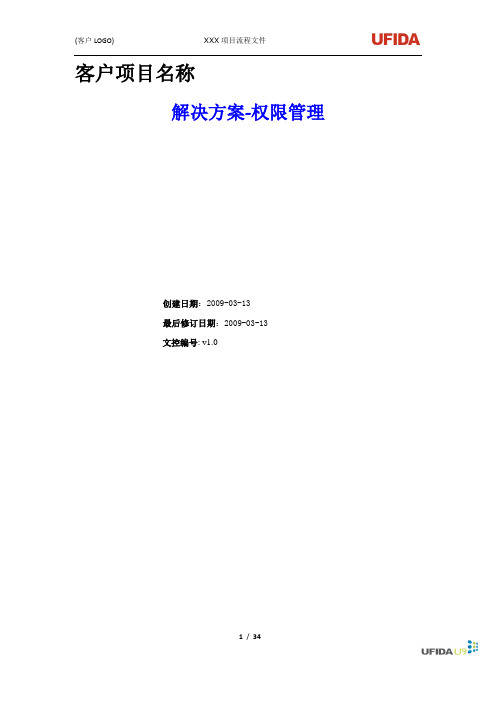
客户项目名称解决方案-权限管理创建日期:2009-03-13最后修订日期:2009-03-13文控编号: v1.0文档控制更改记录审阅审批目录1、应用场景 (4)2、组织关系建立 (4)3、参数配置 (4)4、业务流程及说明 (4)5、场景实现 (6)第一次操作一个新的帐套的时候,先要有组织机构,启用系统才可以分配权限1.EA 进入创建好组织和用户及分配一下角色2.并且给一个用户分配权限为组织管理员和权限管理员3.用组织管理员的帐号进入相应组织,并且启用相应购买和要上线的模块4.然后才能对新建的用户授权1、应用场景权限管理主要用来管理U9各用户对U9系统各节点、表单、动作、字段、服务、数据、属性等功能的使用情况。
例如:对某公司二分厂的一个仓库管理员设定权限,让其只能使用二分厂所在的组织,只能使用库存管理模块的调入单节点,无复制调入单的权限,单头备注只显示但不能编辑,不能删除其他仓管员维护的调入单。
2、组织关系建立3、参数配置4、业务流程及说明户户组织权限户菜单权限限作权限段权限限限5、场景实现5.1、新增用户对于使用U9系统的用户,首先需要在系统中建立需要登陆的用户信息,并定义用户需要使用的登录语言,是否活动,是否生效及生、失效日期等信息。
比如新增仓管员账号。
点击【追溯查询】-【用户所在组织】按钮,查看用户所在组织。
系统新增用户时默认密码为123456,想修改用户密码可点击【操作】-【修改密码】。
5.2、用户加入组织对于新建或者修改的用户,要检查是否已经加入到各组织中,对于用户加入组织,需要注意:1)、只有系统预制超级用户EA才能对组织进行选择;2)、必须先定义用户;3)、必须先定义组织信息;可通过两种方式把用户加入组织:单用户加入到组织中进入组织用户节点,系统默认组织机构为当前组织,如“二分厂”,把光标定位于下面的某一行上,点击【新增】。
再点击账号,弹出画面显示用户列表,选中需要添加的用户后【确定】,再【保存】即可。
基于用友ERP—U8财务软件环境下操作员权限的设置
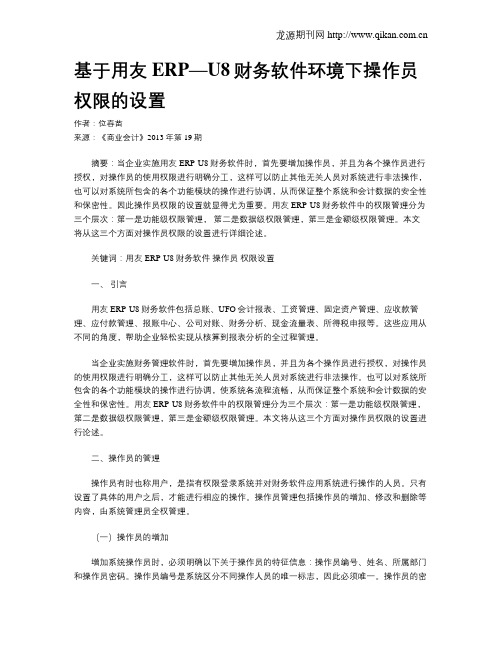
基于用友ERP—U8财务软件环境下操作员权限的设置作者:位春苗来源:《商业会计》2013年第19期摘要:当企业实施用友ERP-U8财务软件时,首先要增加操作员,并且为各个操作员进行授权,对操作员的使用权限进行明确分工,这样可以防止其他无关人员对系统进行非法操作,也可以对系统所包含的各个功能模块的操作进行协调,从而保证整个系统和会计数据的安全性和保密性。
因此操作员权限的设置就显得尤为重要。
用友ERP-U8财务软件中的权限管理分为三个层次:第一是功能级权限管理,第二是数据级权限管理,第三是金额级权限管理。
本文将从这三个方面对操作员权限的设置进行详细论述。
关键词:用友ERP-U8财务软件操作员权限设置一、引言用友ERP-U8财务软件包括总账、UFO会计报表、工资管理、固定资产管理、应收款管理、应付款管理、报账中心、公司对账、财务分析、现金流量表、所得税申报等。
这些应用从不同的角度,帮助企业轻松实现从核算到报表分析的全过程管理。
当企业实施财务管理软件时,首先要增加操作员,并且为各个操作员进行授权,对操作员的使用权限进行明确分工,这样可以防止其他无关人员对系统进行非法操作。
也可以对系统所包含的各个功能模块的操作进行协调,使系统各流程流畅,从而保证整个系统和会计数据的安全性和保密性。
用友ERP-U8财务软件中的权限管理分为三个层次:第一是功能级权限管理,第二是数据级权限管理,第三是金额级权限管理。
本文将从这三个方面对操作员权限的设置进行论述。
二、操作员的管理操作员有时也称用户,是指有权限登录系统并对财务软件应用系统进行操作的人员。
只有设置了具体的用户之后,才能进行相应的操作。
操作员管理包括操作员的增加、修改和删除等内容,由系统管理员全权管理。
(一)操作员的增加增加系统操作员时,必须明确以下关于操作员的特征信息:操作员编号、姓名、所属部门和操作员密码。
操作员编号是系统区分不同操作人员的唯一标志,因此必须唯一。
用友ERP_U8软件操作员权限设置探讨
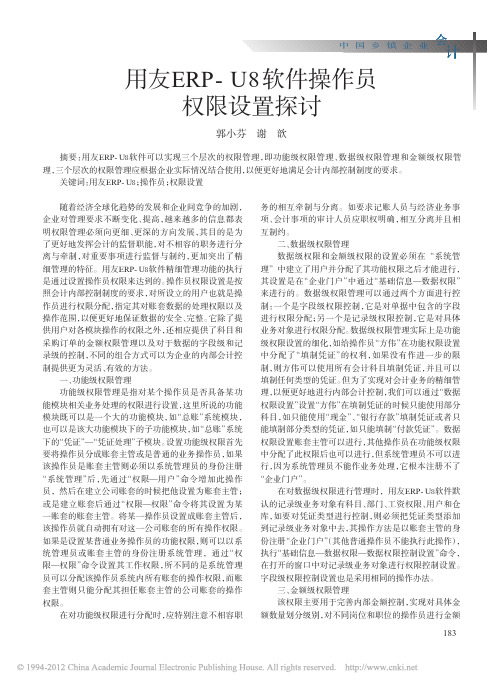
随着经济全球化趋势的发展和企业间竞争的加剧,企业对管理要求不断变化、提高,越来越多的信息都表明权限管理必须向更细、更深的方向发展,其目的是为了更好地发挥会计的监督职能,对不相容的职务进行分离与牵制,对重要事项进行监督与制约,更加突出了精细管理的特征。
用友ERP-U8软件精细管理功能的执行是通过设置操作员权限来达到的。
操作员权限设置是按照会计内部控制制度的要求,对所设立的用户也就是操作员进行权限分配,指定其对账套数据的处理权限以及操作范围,以便更好地保证数据的安全、完整。
它除了提供用户对各模块操作的权限之外,还相应提供了科目和采购订单的金额权限管理以及对于数据的字段级和记录级的控制,不同的组合方式可以为企业的内部会计控制提供更为灵活、有效的方法。
一、功能级权限管理功能级权限管理是指对某个操作员是否具备某功能模块相关业务处理的权限进行设置,这里所说的功能模块既可以是一个大的功能模块,如“总账”系统模块,也可以是该大功能模块下的子功能模块,如“总账”系统下的“凭证”—“凭证处理”子模块。
设置功能级权限首先要将操作员分成账套主管或是普通的业务操作员,如果该操作员是账套主管则必须以系统管理员的身份注册“系统管理”后,先通过“权限—用户”命令增加此操作员,然后在建立公司账套的时候把他设置为账套主管;或是建立账套后通过“权限—权限”命令将其设置为某一账套的账套主管。
将某一操作员设置成账套主管后,该操作员就自动拥有对这一公司账套的所有操作权限。
如果是设置某普通业务操作员的功能权限,则可以以系统管理员或账套主管的身份注册系统管理,通过“权限—权限”命令设置其工作权限,所不同的是系统管理员可以分配该操作员系统内所有账套的操作权限,而账套主管则只能分配其担任账套主管的公司账套的操作权限。
在对功能级权限进行分配时,应特别注意不相容职务的相互牵制与分离。
如要求记账人员与经济业务事项、会计事项的审计人员应职权明确,相互分离并且相互制约。
U8批量进行单据价格权限控制
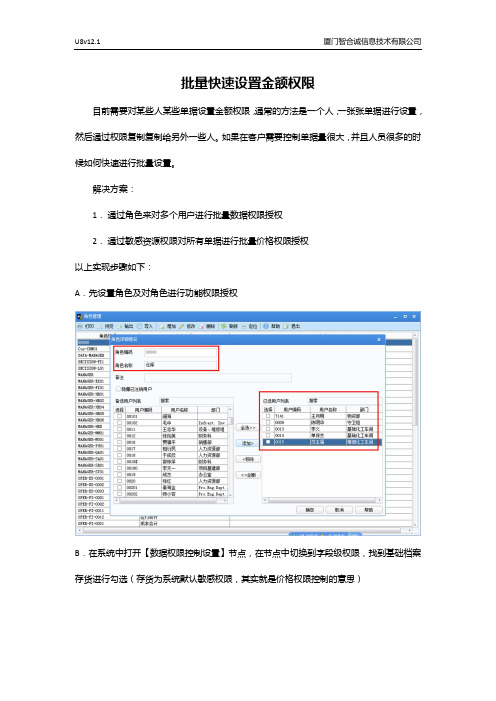
批量快速设置金额权限
目前需要对某些人某些单据设置金额权限,通常的方法是一个人,一张张单据进行设置,然后通过权限复制复制给另外一些人。
如果在客户需要控制单据量很大,并且人员很多的时候如何快速进行批量设置。
解决方案:
1.通过角色来对多个用户进行批量数据权限授权
2.通过敏感资源权限对所有单据进行批量价格权限授权
以上实现步骤如下:
A.先设置角色及对角色进行功能权限授权
B.在系统中打开【数据权限控制设置】节点,在节点中切换到字段级权限,找到基础档案存货进行勾选(存货为系统默认敏感权限,其实就是价格权限控制的意思)
C.设置完后到【数据权限分配】节点找到字段权限,基础档案,存货,授予刚才建立的仓库角色所有存货(金额、成本字段)无权的权限。
保存后用仓库角色下属的人员去系统看看效果吧。
D.系统会自动把所有属于仓库角色下的人员对应的所有单据涉及到价格的字段全部改成无权,具体实现效果如下:。
用友U890权限设置详解
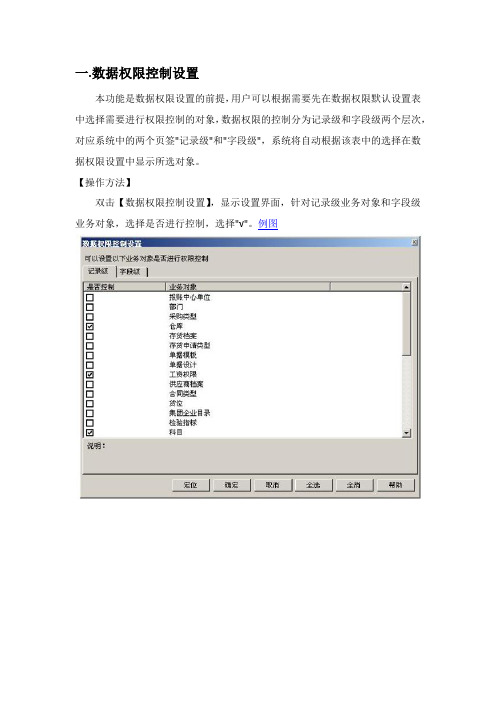
一.数据权限控制设置本功能是数据权限设置的前提,用户可以根据需要先在数据权限默认设置表中选择需要进行权限控制的对象,数据权限的控制分为记录级和字段级两个层次,对应系统中的两个页签"记录级"和"字段级",系统将自动根据该表中的选择在数据权限设置中显示所选对象。
【操作方法】双击【数据权限控制设置】,显示设置界面,针对记录级业务对象和字段级业务对象,选择是否进行控制,选择"√"。
例图提示1.敏感数据权限控制(1)对不同业务对象(如单据、报表、列表、参照等)同一含义的字段统一控制数据权限,以避免用户对每个业务对象都要进行权限设置及分配,提高了字段级权限控制的易用性。
(2)UAP平台提供了[敏感数据维护工具],登录U8UAP进行业务对象的定义及维护;(3)分级定义或维护业务对象的属性;(4)把敏感对象的末级属性与相关业务对象的字段进行映射;(5)登录U8应用平台,打开数据权限控制窗口,选择"字段"页签,选中在UAP定义的业务对象控制权限;(6)打开数据权限设置窗口,选择用户、选择业务对象,通过对业务对象某属性的授权,进而完成了此属性映射字段的授权。
提示:详细说明请参见UAP帮助2.系统预置了3个敏感业务对象:存货、供应商、客户。
3.账套主管不参加数据权限分配。
4.对应每一个业务对象,其权限的控制范围在数据权限默认控制界面和权限设置界面中均有一个简单说明。
5.如果是集团账套,则在数据权限控制设置中增加"集团企业目录"档案的选择。
6."默认权限"列,可以按业务对象设置默认"有权"还是"无权"。
二、数据权限设置必须在系统管理中定义角色或用户,并分配完功能级权限后才能在这里进行"数据权限分配"。
数据级权限分配包括:1.记录权限分配:是指对具体业务对象进行权限分配。
基于用友ERP-U8财务软件环境下操作员权限的设置
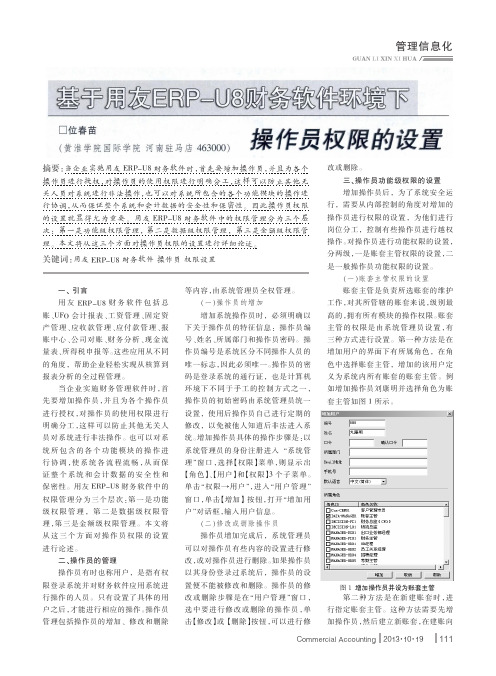
用友U8数据权限设置

客户权限设置操作手册
1、设置数据权限控制设置
点开系统服务,点击权限,点中数据权限控制设置
2、选择控制项目
选中客户档案和客户权限维度
3、数据权限分配
点击数据权限分配,点击左边的需要分配的人员
右边选择记录中的客户权限维度
上面选择维度档案
维护档案:可以以业务员的名称分类
设置好客户权限维度之后推出该界面,点击上方档案分配
左边选择分类名,上边默认选择分类,右边将可分配内容选择到右边分类里面点击保存会有提示重新登录后生效
退出分配界面选择授权
将各自分类分配给各自人员
退出以上界面
选择维度控制方式权限改为本级
4、设置客户权限
设置销售管理-选项
业务控制中控制客户权限打勾,以上设置全部完成。
用友U8 V11.0公共插件V7.0操作手册(生产订单、委外订单子件批量调整)
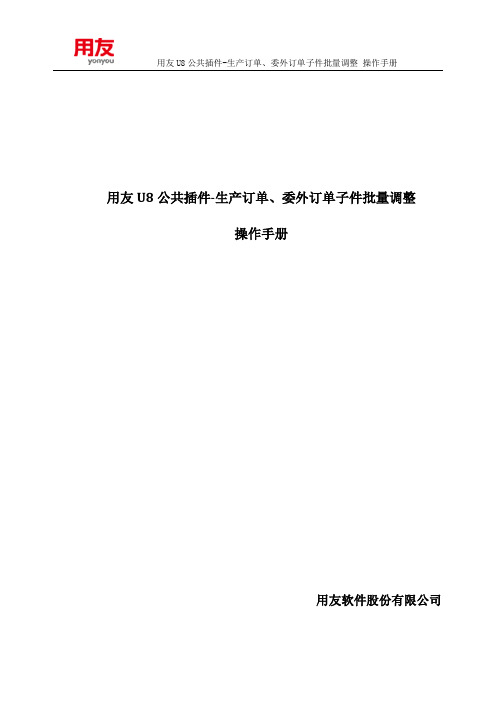
用友U8公共插件-生产订单、委外订单子件批量调整操作手册用友软件股份有限公司使用说明1生产订单子件批量调整将订单子件替换成BOM中已定义好的替换件(按替代件替换),同时提供临时物料替换功能(高级替换)插件安装成功后会在U8 的[生产制造\生产订单\生产订单生成] 下多出一菜单节点[生产订单子件批量调整]。
点击此节点,即弹出如下窗口:此窗口中有两种选择:1.1按替代件替换“按替代件替换”用于将订单子件替换成BOM中已定义好的替代件。
点击“确定”按钮弹出过滤窗口:选择条件后,点击过滤,弹出主窗体。
生产订单子件必须有替代件才能被过滤出来。
代件的信息。
勾选子件列表的“选择”列来选择要进行子件调整的子件范围。
设置完成后,点击工具栏上的“替换”按钮进行替换。
弹出提示窗口。
点击“是”,弹出替换成功的提示窗口,并显示详细的替换信息。
关闭信息窗口,窗体执行刷新操作。
1.2高级替换高级替换功能主要用于将订单子件替换成未在BOM 中定义替代件的物料。
选择高级替换:确定后进入过滤界面选择过滤,弹出主窗体,此时父项列表列出所有的生产订单信息。
勾选父项列表的行来选择要进行子件调整的生产订单范围。
在被替换件列表中单击增行按钮,选择要被替换的子件,可多选。
在右侧替换件列表中单击增行按钮,选择替换件,此替换件不是BOM中定义的替换件,而是临时替换,包含所有子件信息。
可多选。
设置被替换件信息、替换件替换模式为“可分组替换”,即设置多个替换组,然后同时执行替换操作。
比如:定义组1――子件物料A1、子件物料A2、替换件S1、替换件S2、替换件S3,表明需要将子件物料A1、A2替换成物料S1、S2、S3。
以此类推可定义多个组。
设置完成后,单击替换按钮,弹出提示信息窗口。
注意:需要通过选择不同的父项来分别设置子件的替换信息。
1)选择父项的某一行订单明细。
2)点击被替换件的“增行”按钮以及选择组号和物料编码可以设置一组或多组的被替换件物料信息;3)点击替换件的“增行”按钮以及选择组号、物料编码、工序行号、基本用量、应领数量等一系列信息可以设置一组或多组的替换件物料信息。
用友软件 NCV63平台篇--权限管理

细粒度的业务职责;功能点是对应一个FORM的、包含多个相关业务活动的综合功能包
数据对象:具体的业务对象,如甲公司、乙部门等等,包括所有涉及到数据权限的对象值; 权限:角色/用户可访问的资源及其操作,具体在我们产品中在部分通过功能权限和数据权限来体现 职责:某种业务职能(如库管)具备的权限范围,在系统中体现为一些和组织无关的功能点和业务活
目录
基本模型和概念 授权控制模型
功能权限 数据权限
权限的分权管理体系
角色的系统分类 授权权 用户管理
其他的高价值特性
yonyou software Co., Ltd.
功能权限的授权要素
功能权限的授权资源
功能权限的授权资源为: 功能点--组织 --页签--组织 --业务活动 --业务活动
我们的功能权限除了以功能为资源对象外,还打包了组织权限
功能权限
功能权限的授权资源是功能点和业务活动。 产品功能是通过菜单呈现的。功能权限授权时只是通过菜单进行功能的导航选择。但是我们依然通过 被授权的功能与菜单元素的绑定关系来处理其菜单元素的可见性 授权方式仅支持正向,权限控制的效果是:未授权,用户对该功能不可用;反之可用
组织权限
每个功能点必需有一个主组织类型,可以是:全局、集团、业务单元、或其它组织类型 全局级功能点是跨集团使用的,其权限也不受其授予集团的约束 主组织是功能授权默认的逻辑区分分类,NC每个功能点都有其主组织,分配功能点权限后还要指定 有权限的主组织。组织级功能授权时不指定主组织,认为没有任何主组织权限,事实上功能权限无效
集团级职能 管理员
系统管理员
用友批量修改权限

批量修改权限问题现象客户需要给全部帐套固定的权限如果给全部权限的话还不行如果从前台增加的话那么一个一个点太慢了解决思路前台点太慢是不是可以从某个表直接插入,尝试以后决定从后台增加解决办法insert into ua_holdauth(cAcc_Id, iYear, cUser_Id, cAuth_Id, iIsUser, csub_id, cAuthType, cRepellent, cRepellentModule, cNotRepellent) select 001,2012 ,cUser_Id,cAuth_Id,iIsUser,csub_id,cAuthType, cRepellent, cRepellentModule, cNotRepellent from ua_holdauth where cuser_id='all'and cacc_id=001 and iyear=2011insert into ua_holdauth(cAcc_Id, iYear, cUser_Id, cAuth_Id, iIsUser, csub_id, cAuthType, cRepellent, cRepellentModule, cNotRepellent) select 002,2013 ,cUser_Id,cAuth_Id,iIsUser,csub_id,cAuthType, cRepellent, cRepellentModule, cNotRepellent from ua_holdauth where cuser_id='all'and cacc_id=001 and iyear=2011insert into ua_holdauth(cAcc_Id, iYear, cUser_Id, cAuth_Id, iIsUser, csub_id, cAuthType, cRepellent, cRepellentModule, cNotRepellent) select 002,2014 ,cUser_Id,cAuth_Id,iIsUser,csub_id,cAuthType, cRepellent, cRepellentModule, cNotRepellent from ua_holdauth where cuser_id='all'and cacc_id=001 and iyear=2011insert into ua_holdauth(cAcc_Id, iYear, cUser_Id, cAuth_Id, iIsUser, csub_id, cAuthType, cRepellent, cRepellentModule, cNotRepellent) select 003,2012 ,cUser_Id,cAuth_Id,iIsUser,csub_id,cAuthType, cRepellent, cRepellentModule, cNotRepellent from ua_holdauth where cuser_id='all'and cacc_id=001 and iyear=2011insert into ua_holdauth(cAcc_Id, iYear, cUser_Id, cAuth_Id, iIsUser, csub_id, cAuthType, cRepellent, cRepellentModule, cNotRepellent) select 003,2013 ,cUser_Id,cAuth_Id,iIsUser,csub_id,cAuthType, cRepellent, cRepellentModule, cNotRepellent from ua_holdauth where cuser_id='all'and cacc_id=001 and iyear=2011insert into ua_holdauth(cAcc_Id, iYear, cUser_Id, cAuth_Id, iIsUser, csub_id, cAuthType, cRepellent, cRepellentModule, cNotRepellent) select 003,2014 ,cUser_Id,cAuth_Id,iIsUser,csub_id,cAuthType, cRepellent, cRepellentModule, cNotRepellent from ua_holdauth where cuser_id='all'and cacc_id=001 and iyear=2011insert into ua_holdauth(cAcc_Id, iYear, cUser_Id, cAuth_Id, iIsUser, csub_id, cAuthType, cRepellent, cRepellentModule, cNotRepellent) select 101,2006 ,cUser_Id,cAuth_Id,iIsUser,csub_id,cAuthType,cRepellent, cRepellentModule, cNotRepellent from ua_holdauth where cuser_id='all'and cacc_id=001 and iyear=2011insert into ua_holdauth(cAcc_Id, iYear, cUser_Id, cAuth_Id, iIsUser, csub_id, cAuthType, cRepellent, cRepellentModule, cNotRepellent) select 101,2007 ,cUser_Id,cAuth_Id,iIsUser,csub_id,cAuthType, cRepellent, cRepellentModule, cNotRepellent from ua_holdauth where cuser_id='all'and cacc_id=001 and iyear=2011insert into ua_holdauth(cAcc_Id, iYear, cUser_Id, cAuth_Id, iIsUser, csub_id, cAuthType, cRepellent, cRepellentModule, cNotRepellent) select 101,2008 ,cUser_Id,cAuth_Id,iIsUser,csub_id,cAuthType, cRepellent, cRepellentModule, cNotRepellent from ua_holdauth where cuser_id='all'and cacc_id=001 and iyear=2011insert into ua_holdauth(cAcc_Id, iYear, cUser_Id, cAuth_Id, iIsUser, csub_id, cAuthType, cRepellent, cRepellentModule, cNotRepellent) select 101,2009 ,cUser_Id,cAuth_Id,iIsUser,csub_id,cAuthType, cRepellent, cRepellentModule, cNotRepellent from ua_holdauth where cuser_id='all'and cacc_id=001 and iyear=2011insert into ua_holdauth(cAcc_Id, iYear, cUser_Id, cAuth_Id, iIsUser, csub_id, cAuthType, cRepellent, cRepellentModule, cNotRepellent) select 101,2010 ,cUser_Id,cAuth_Id,iIsUser,csub_id,cAuthType, cRepellent, cRepellentModule, cNotRepellent from ua_holdauth where cuser_id='all'and cacc_id=001 and iyear=2011insert into ua_holdauth(cAcc_Id, iYear, cUser_Id, cAuth_Id, iIsUser, csub_id, cAuthType, cRepellent, cRepellentModule, cNotRepellent) select 101,2011 ,cUser_Id,cAuth_Id,iIsUser,csub_id,cAuthType, cRepellent, cRepellentModule, cNotRepellent from ua_holdauth where cuser_id='all'and cacc_id=001 and iyear=2011insert into ua_holdauth(cAcc_Id, iYear, cUser_Id, cAuth_Id, iIsUser, csub_id, cAuthType, cRepellent, cRepellentModule, cNotRepellent) select 101,2012 ,cUser_Id,cAuth_Id,iIsUser,csub_id,cAuthType, cRepellent, cRepellentModule, cNotRepellent from ua_holdauth where cuser_id='all'and cacc_id=001 and iyear=2011insert into ua_holdauth(cAcc_Id, iYear, cUser_Id, cAuth_Id, iIsUser, csub_id, cAuthType, cRepellent, cRepellentModule, cNotRepellent) select 101,2013 ,cUser_Id,cAuth_Id,iIsUser,csub_id,cAuthType, cRepellent, cRepellentModule, cNotRepellent from ua_holdauth where cuser_id='all'and cacc_id=001 and iyear=2011insert into ua_holdauth(cAcc_Id, iYear, cUser_Id, cAuth_Id, iIsUser, csub_id, cAuthType, cRepellent, cRepellentModule, cNotRepellent) select 101,2014 ,cUser_Id,cAuth_Id,iIsUser,csub_id,cAuthType, cRepellent, cRepellentModule, cNotRepellent from ua_holdauth where cuser_id='all'and cacc_id=001 and iyear=2011insert into ua_holdauth(cAcc_Id, iYear, cUser_Id, cAuth_Id, iIsUser, csub_id, cAuthType, cRepellent, cRepellentModule, cNotRepellent)select 102,2010 ,cUser_Id,cAuth_Id,iIsUser,csub_id,cAuthType, cRepellent, cRepellentModule, cNotRepellent from ua_holdauth where cuser_id='all'and cacc_id=001 and iyear=2011insert into ua_holdauth(cAcc_Id, iYear, cUser_Id, cAuth_Id, iIsUser, csub_id, cAuthType, cRepellent, cRepellentModule, cNotRepellent) select 102,2011 ,cUser_Id,cAuth_Id,iIsUser,csub_id,cAuthType, cRepellent, cRepellentModule, cNotRepellent from ua_holdauth where cuser_id='all'and cacc_id=001 and iyear=2011insert into ua_holdauth(cAcc_Id, iYear, cUser_Id, cAuth_Id, iIsUser, csub_id, cAuthType, cRepellent, cRepellentModule, cNotRepellent) select 102,2012 ,cUser_Id,cAuth_Id,iIsUser,csub_id,cAuthType, cRepellent, cRepellentModule, cNotRepellent from ua_holdauth where cuser_id='all'and cacc_id=001 and iyear=2011insert into ua_holdauth(cAcc_Id, iYear, cUser_Id, cAuth_Id, iIsUser, csub_id, cAuthType, cRepellent, cRepellentModule, cNotRepellent) select 102,2013 ,cUser_Id,cAuth_Id,iIsUser,csub_id,cAuthType, cRepellent, cRepellentModule, cNotRepellent from ua_holdauth where cuser_id='all'and cacc_id=001 and iyear=2011insert into ua_holdauth(cAcc_Id, iYear, cUser_Id, cAuth_Id, iIsUser, csub_id, cAuthType, cRepellent, cRepellentModule, cNotRepellent) select 102,2014 ,cUser_Id,cAuth_Id,iIsUser,csub_id,cAuthType, cRepellent, cRepellentModule, cNotRepellent from ua_holdauth where cuser_id='all'and cacc_id=001 and iyear=2011insert into ua_holdauth(cAcc_Id, iYear, cUser_Id, cAuth_Id, iIsUser, csub_id, cAuthType, cRepellent, cRepellentModule, cNotRepellent) select 103,2002 ,cUser_Id,cAuth_Id,iIsUser,csub_id,cAuthType, cRepellent, cRepellentModule, cNotRepellent from ua_holdauth where cuser_id='all'and cacc_id=001 and iyear=2011insert into ua_holdauth(cAcc_Id, iYear, cUser_Id, cAuth_Id, iIsUser, csub_id, cAuthType, cRepellent, cRepellentModule, cNotRepellent) select 103,2003 ,cUser_Id,cAuth_Id,iIsUser,csub_id,cAuthType, cRepellent, cRepellentModule, cNotRepellent from ua_holdauth where cuser_id='all'and cacc_id=001 and iyear=2011insert into ua_holdauth(cAcc_Id, iYear, cUser_Id, cAuth_Id, iIsUser, csub_id, cAuthType, cRepellent, cRepellentModule, cNotRepellent) select 103,2004 ,cUser_Id,cAuth_Id,iIsUser,csub_id,cAuthType, cRepellent, cRepellentModule, cNotRepellent from ua_holdauth where cuser_id='all'and cacc_id=001 and iyear=2011insert into ua_holdauth(cAcc_Id, iYear, cUser_Id, cAuth_Id, iIsUser, csub_id, cAuthType, cRepellent, cRepellentModule, cNotRepellent) select 103,2005 ,cUser_Id,cAuth_Id,iIsUser,csub_id,cAuthType, cRepellent, cRepellentModule, cNotRepellent from ua_holdauth where cuser_id='all'and cacc_id=001 and iyear=2011insert into ua_holdauth(cAcc_Id, iYear, cUser_Id, cAuth_Id, iIsUser,。
【新提醒】教你批量修改文件权限。不用一个个的修改权限再放入系统了
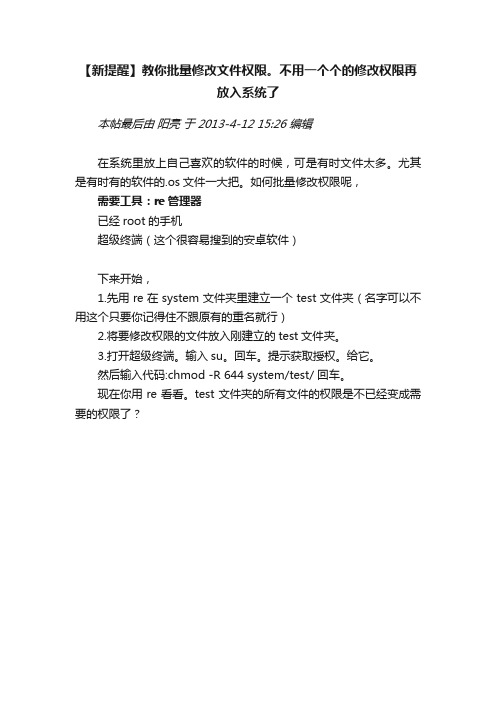
【新提醒】教你批量修改文件权限。
不用一个个的修改权限再
放入系统了
本帖最后由阳亮于 2013-4-12 15:26 编辑
在系统里放上自己喜欢的软件的时候,可是有时文件太多。
尤其是有时有的软件的.os文件一大把。
如何批量修改权限呢,需要工具:re管理器
已经root的手机
超级终端(这个很容易搜到的安卓软件)
下来开始,
1.先用re在system文件夹里建立一个test文件夹(名字可以不用这个只要你记得住不跟原有的重名就行)
2.将要修改权限的文件放入刚建立的test文件夹。
3.打开超级终端。
输入su。
回车。
提示获取授权。
给它。
然后输入代码:chmod -R 644 system/test/ 回车。
现在你用re看看。
test文件夹的所有文件的权限是不已经变成需要的权限了?。
3 用友批量修改方法
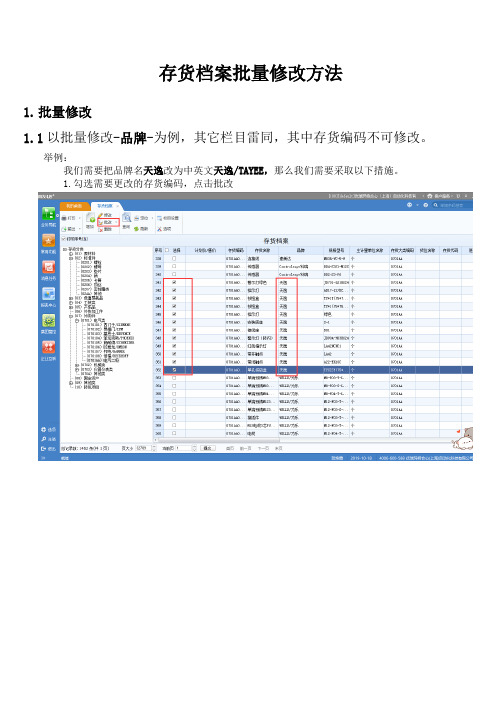
存货档案批量修改方法
1.批量修改
1.1以批量修改-品牌-为例,其它栏目雷同,其中存货编码不可修改。
举例:
我们需要把品牌名天逸改为中英文天逸/TAYEE,那么我们需要采取以下措施。
1.勾选需要更改的存货编码,点击批改
2.在新出现的批改界面内点击-增行-
2.在新的增行内-项目名称-栏目内填写产地/品牌,-修改内容-内填写天逸/TAYEE
4.在条件选择下属栏目填写相应内容,然后勾选按所选记录批量修改,点击-下一步-。
5.点击执行
6.修改内容预览界面,请确认是否批量修改?点击是
7.出现提示信息:存货信息批改完成,共修改12条,点击-确定
8.批改完成。
9.其它栏目雷同,其中存货编码不可修改.。
- 1、下载文档前请自行甄别文档内容的完整性,平台不提供额外的编辑、内容补充、找答案等附加服务。
- 2、"仅部分预览"的文档,不可在线预览部分如存在完整性等问题,可反馈申请退款(可完整预览的文档不适用该条件!)。
- 3、如文档侵犯您的权益,请联系客服反馈,我们会尽快为您处理(人工客服工作时间:9:00-18:30)。
批量修改权限问题现象客户需要给全部帐套固定的权限如果给全部权限的话还不行如果从前台增加的话那么一个一个点太慢了解决思路前台点太慢是不是可以从某个表直接插入,尝试以后决定从后台增加解决办法insert into ua_holdauth(cAcc_Id, iYear, cUser_Id, cAuth_Id, iIsUser, csub_id, cAuthType, cRepellent, cRepellentModule, cNotRepellent)select 001,2012 ,cUser_Id,cAuth_Id,iIsUser,csub_id,cAuthType, cRepellent, cRepellentModule, cNotRepellent from ua_holdauth where cuser_id='all'and cacc_id=001 and iyear=2011insert into ua_holdauth(cAcc_Id, iYear, cUser_Id, cAuth_Id, iIsUser, csub_id, cAuthType, cRepellent, cRepellentModule, cNotRepellent) select 002,2013 ,cUser_Id,cAuth_Id,iIsUser,csub_id,cAuthType, cRepellent, cRepellentModule, cNotRepellent from ua_holdauth where cuser_id='all'and cacc_id=001 and iyear=2011insert into ua_holdauth(cAcc_Id, iYear, cUser_Id, cAuth_Id, iIsUser, csub_id, cAuthType, cRepellent, cRepellentModule, cNotRepellent) select 002,2014 ,cUser_Id,cAuth_Id,iIsUser,csub_id,cAuthType, cRepellent, cRepellentModule, cNotRepellent from ua_holdauth where cuser_id='all'and cacc_id=001 and iyear=2011insert into ua_holdauth(cAcc_Id, iYear, cUser_Id, cAuth_Id, iIsUser, csub_id, cAuthType, cRepellent, cRepellentModule, cNotRepellent) select 003,2012 ,cUser_Id,cAuth_Id,iIsUser,csub_id,cAuthType, cRepellent, cRepellentModule, cNotRepellent from ua_holdauth where cuser_id='all'and cacc_id=001 and iyear=2011insert into ua_holdauth(cAcc_Id, iYear, cUser_Id, cAuth_Id, iIsUser, csub_id, cAuthType, cRepellent, cRepellentModule, cNotRepellent) select 003,2013 ,cUser_Id,cAuth_Id,iIsUser,csub_id,cAuthType, cRepellent, cRepellentModule, cNotRepellent from ua_holdauth where cuser_id='all'and cacc_id=001 and iyear=2011insert into ua_holdauth(cAcc_Id, iYear, cUser_Id, cAuth_Id, iIsUser, csub_id, cAuthType, cRepellent, cRepellentModule, cNotRepellent) select 003,2014 ,cUser_Id,cAuth_Id,iIsUser,csub_id,cAuthType, cRepellent, cRepellentModule, cNotRepellent from ua_holdauth where cuser_id='all'and cacc_id=001 and iyear=2011insert into ua_holdauth(cAcc_Id, iYear, cUser_Id, cAuth_Id, iIsUser, csub_id, cAuthType, cRepellent, cRepellentModule, cNotRepellent) select 101,2006 ,cUser_Id,cAuth_Id,iIsUser,csub_id,cAuthType, cRepellent, cRepellentModule, cNotRepellent from ua_holdauth where cuser_id='all'and cacc_id=001 and iyear=2011insert into ua_holdauth(cAcc_Id, iYear, cUser_Id, cAuth_Id, iIsUser, csub_id, cAuthType, cRepellent, cRepellentModule, cNotRepellent) select 101,2007 ,cUser_Id,cAuth_Id,iIsUser,csub_id,cAuthType, cRepellent, cRepellentModule, cNotRepellent from ua_holdauth where cuser_id='all'and cacc_id=001 and iyear=2011insert into ua_holdauth(cAcc_Id, iYear, cUser_Id, cAuth_Id, iIsUser, csub_id, cAuthType, cRepellent, cRepellentModule, cNotRepellent) select 101,2008 ,cUser_Id,cAuth_Id,iIsUser,csub_id,cAuthType, cRepellent, cRepellentModule, cNotRepellent from ua_holdauth where cuser_id='all'and cacc_id=001 and iyear=2011insert into ua_holdauth(cAcc_Id, iYear, cUser_Id, cAuth_Id, iIsUser,csub_id, cAuthType, cRepellent, cRepellentModule, cNotRepellent) select 101,2009 ,cUser_Id,cAuth_Id,iIsUser,csub_id,cAuthType, cRepellent, cRepellentModule, cNotRepellent from ua_holdauth where cuser_id='all'and cacc_id=001 and iyear=2011insert into ua_holdauth(cAcc_Id, iYear, cUser_Id, cAuth_Id, iIsUser, csub_id, cAuthType, cRepellent, cRepellentModule, cNotRepellent) select 101,2010 ,cUser_Id,cAuth_Id,iIsUser,csub_id,cAuthType, cRepellent, cRepellentModule, cNotRepellent from ua_holdauth where cuser_id='all'and cacc_id=001 and iyear=2011insert into ua_holdauth(cAcc_Id, iYear, cUser_Id, cAuth_Id, iIsUser, csub_id, cAuthType, cRepellent, cRepellentModule, cNotRepellent) select 101,2011 ,cUser_Id,cAuth_Id,iIsUser,csub_id,cAuthType, cRepellent, cRepellentModule, cNotRepellent from ua_holdauth where cuser_id='all'and cacc_id=001 and iyear=2011insert into ua_holdauth(cAcc_Id, iYear, cUser_Id, cAuth_Id, iIsUser, csub_id, cAuthType, cRepellent, cRepellentModule, cNotRepellent) select 101,2012 ,cUser_Id,cAuth_Id,iIsUser,csub_id,cAuthType, cRepellent, cRepellentModule, cNotRepellent from ua_holdauth where cuser_id='all'and cacc_id=001 and iyear=2011insert into ua_holdauth(cAcc_Id, iYear, cUser_Id, cAuth_Id, iIsUser, csub_id, cAuthType, cRepellent, cRepellentModule, cNotRepellent) select 101,2013 ,cUser_Id,cAuth_Id,iIsUser,csub_id,cAuthType, cRepellent, cRepellentModule, cNotRepellent from ua_holdauth where cuser_id='all'and cacc_id=001 and iyear=2011insert into ua_holdauth(cAcc_Id, iYear, cUser_Id, cAuth_Id, iIsUser, csub_id, cAuthType, cRepellent, cRepellentModule, cNotRepellent) select 101,2014 ,cUser_Id,cAuth_Id,iIsUser,csub_id,cAuthType, cRepellent, cRepellentModule, cNotRepellent from ua_holdauth where cuser_id='all'and cacc_id=001 and iyear=2011insert into ua_holdauth(cAcc_Id, iYear, cUser_Id, cAuth_Id, iIsUser, csub_id, cAuthType, cRepellent, cRepellentModule, cNotRepellent) select 102,2010 ,cUser_Id,cAuth_Id,iIsUser,csub_id,cAuthType, cRepellent, cRepellentModule, cNotRepellent from ua_holdauth where cuser_id='all'and cacc_id=001 and iyear=2011insert into ua_holdauth(cAcc_Id, iYear, cUser_Id, cAuth_Id, iIsUser, csub_id, cAuthType, cRepellent, cRepellentModule, cNotRepellent) select 102,2011 ,cUser_Id,cAuth_Id,iIsUser,csub_id,cAuthType, cRepellent, cRepellentModule, cNotRepellent from ua_holdauth where cuser_id='all'and cacc_id=001 and iyear=2011insert into ua_holdauth(cAcc_Id, iYear, cUser_Id, cAuth_Id, iIsUser, csub_id, cAuthType, cRepellent, cRepellentModule, cNotRepellent) select 102,2012 ,cUser_Id,cAuth_Id,iIsUser,csub_id,cAuthType, cRepellent, cRepellentModule, cNotRepellent from ua_holdauth where cuser_id='all'and cacc_id=001 and iyear=2011insert into ua_holdauth(cAcc_Id, iYear, cUser_Id, cAuth_Id, iIsUser, csub_id, cAuthType, cRepellent, cRepellentModule, cNotRepellent) select 102,2013 ,cUser_Id,cAuth_Id,iIsUser,csub_id,cAuthType, cRepellent, cRepellentModule, cNotRepellent from ua_holdauth where cuser_id='all'and cacc_id=001 and iyear=2011insert into ua_holdauth(cAcc_Id, iYear, cUser_Id, cAuth_Id, iIsUser, csub_id, cAuthType, cRepellent, cRepellentModule, cNotRepellent) select 102,2014 ,cUser_Id,cAuth_Id,iIsUser,csub_id,cAuthType, cRepellent, cRepellentModule, cNotRepellent from ua_holdauth where cuser_id='all'and cacc_id=001 and iyear=2011insert into ua_holdauth(cAcc_Id, iYear, cUser_Id, cAuth_Id, iIsUser, csub_id, cAuthType, cRepellent, cRepellentModule, cNotRepellent) select 103,2002 ,cUser_Id,cAuth_Id,iIsUser,csub_id,cAuthType, cRepellent, cRepellentModule, cNotRepellent from ua_holdauth where cuser_id='all'and cacc_id=001 and iyear=2011insert into ua_holdauth(cAcc_Id, iYear, cUser_Id, cAuth_Id, iIsUser, csub_id, cAuthType, cRepellent, cRepellentModule, cNotRepellent) select 103,2003 ,cUser_Id,cAuth_Id,iIsUser,csub_id,cAuthType, cRepellent, cRepellentModule, cNotRepellent from ua_holdauth where cuser_id='all'and cacc_id=001 and iyear=2011insert into ua_holdauth(cAcc_Id, iYear, cUser_Id, cAuth_Id, iIsUser, csub_id, cAuthType, cRepellent, cRepellentModule, cNotRepellent) select 103,2004 ,cUser_Id,cAuth_Id,iIsUser,csub_id,cAuthType, cRepellent, cRepellentModule, cNotRepellent from ua_holdauth where cuser_id='all'and cacc_id=001 and iyear=2011insert into ua_holdauth(cAcc_Id, iYear, cUser_Id, cAuth_Id, iIsUser, csub_id, cAuthType, cRepellent, cRepellentModule, cNotRepellent) select 103,2005 ,cUser_Id,cAuth_Id,iIsUser,csub_id,cAuthType, cRepellent, cRepellentModule, cNotRepellent from ua_holdauth where cuser_id='all'and cacc_id=001 and iyear=2011insert into ua_holdauth(cAcc_Id, iYear, cUser_Id, cAuth_Id, iIsUser, csub_id, cAuthType, cRepellent, cRepellentModule, cNotRepellent) select 103,2006 ,cUser_Id,cAuth_Id,iIsUser,csub_id,cAuthType, cRepellent, cRepellentModule, cNotRepellent from ua_holdauth where cuser_id='all'and cacc_id=001 and iyear=2011insert into ua_holdauth(cAcc_Id, iYear, cUser_Id, cAuth_Id, iIsUser, csub_id, cAuthType, cRepellent, cRepellentModule, cNotRepellent) select 103,2007 ,cUser_Id,cAuth_Id,iIsUser,csub_id,cAuthType, cRepellent, cRepellentModule, cNotRepellent from ua_holdauth where cuser_id='all'and cacc_id=001 and iyear=2011insert into ua_holdauth(cAcc_Id, iYear, cUser_Id, cAuth_Id, iIsUser, csub_id, cAuthType, cRepellent, cRepellentModule, cNotRepellent) select 103,2008 ,cUser_Id,cAuth_Id,iIsUser,csub_id,cAuthType, cRepellent, cRepellentModule, cNotRepellent from ua_holdauth wherecuser_id='all'and cacc_id=001 and iyear=2011insert into ua_holdauth(cAcc_Id, iYear, cUser_Id, cAuth_Id, iIsUser, csub_id, cAuthType, cRepellent, cRepellentModule, cNotRepellent) select 103,2009 ,cUser_Id,cAuth_Id,iIsUser,csub_id,cAuthType, cRepellent, cRepellentModule, cNotRepellent from ua_holdauth where cuser_id='all'and cacc_id=001 and iyear=2011insert into ua_holdauth(cAcc_Id, iYear, cUser_Id, cAuth_Id, iIsUser, csub_id, cAuthType, cRepellent, cRepellentModule, cNotRepellent) select 103,2010 ,cUser_Id,cAuth_Id,iIsUser,csub_id,cAuthType, cRepellent, cRepellentModule, cNotRepellent from ua_holdauth where cuser_id='all'and cacc_id=001 and iyear=2011insert into ua_holdauth(cAcc_Id, iYear, cUser_Id, cAuth_Id, iIsUser, csub_id, cAuthType, cRepellent, cRepellentModule, cNotRepellent) select 103,2011 ,cUser_Id,cAuth_Id,iIsUser,csub_id,cAuthType, cRepellent, cRepellentModule, cNotRepellent from ua_holdauth where cuser_id='all'and cacc_id=001 and iyear=2011insert into ua_holdauth(cAcc_Id, iYear, cUser_Id, cAuth_Id, iIsUser, csub_id, cAuthType, cRepellent, cRepellentModule, cNotRepellent) select 103,2012 ,cUser_Id,cAuth_Id,iIsUser,csub_id,cAuthType, cRepellent, cRepellentModule, cNotRepellent from ua_holdauth where cuser_id='all'and cacc_id=001 and iyear=2011insert into ua_holdauth(cAcc_Id, iYear, cUser_Id, cAuth_Id, iIsUser, csub_id, cAuthType, cRepellent, cRepellentModule, cNotRepellent) select 103,2013 ,cUser_Id,cAuth_Id,iIsUser,csub_id,cAuthType, cRepellent, cRepellentModule, cNotRepellent from ua_holdauth where cuser_id='all'and cacc_id=001 and iyear=2011insert into ua_holdauth(cAcc_Id, iYear, cUser_Id, cAuth_Id, iIsUser, csub_id, cAuthType, cRepellent, cRepellentModule, cNotRepellent) select 109,2011 ,cUser_Id,cAuth_Id,iIsUser,csub_id,cAuthType, cRepellent, cRepellentModule, cNotRepellent from ua_holdauth where cuser_id='all'and cacc_id=001 and iyear=2011insert into ua_holdauth(cAcc_Id, iYear, cUser_Id, cAuth_Id, iIsUser, csub_id, cAuthType, cRepellent, cRepellentModule, cNotRepellent) select 111,2013 ,cUser_Id,cAuth_Id,iIsUser,csub_id,cAuthType, cRepellent, cRepellentModule, cNotRepellent from ua_holdauth where cuser_id='all'and cacc_id=001 and iyear=2011insert into ua_holdauth(cAcc_Id, iYear, cUser_Id, cAuth_Id, iIsUser, csub_id, cAuthType, cRepellent, cRepellentModule, cNotRepellent) select 111,2014 ,cUser_Id,cAuth_Id,iIsUser,csub_id,cAuthType, cRepellent, cRepellentModule, cNotRepellent from ua_holdauth where cuser_id='all'and cacc_id=001 and iyear=2011insert into ua_holdauth(cAcc_Id, iYear, cUser_Id, cAuth_Id, iIsUser, csub_id, cAuthType, cRepellent, cRepellentModule, cNotRepellent) select 112,2013 ,cUser_Id,cAuth_Id,iIsUser,csub_id,cAuthType,cRepellent, cRepellentModule, cNotRepellent from ua_holdauth where cuser_id='all'and cacc_id=001 and iyear=2011insert into ua_holdauth(cAcc_Id, iYear, cUser_Id, cAuth_Id, iIsUser, csub_id, cAuthType, cRepellent, cRepellentModule, cNotRepellent) select 112,2014 ,cUser_Id,cAuth_Id,iIsUser,csub_id,cAuthType, cRepellent, cRepellentModule, cNotRepellent from ua_holdauth where cuser_id='all'and cacc_id=001 and iyear=2011insert into ua_holdauth(cAcc_Id, iYear, cUser_Id, cAuth_Id, iIsUser, csub_id, cAuthType, cRepellent, cRepellentModule, cNotRepellent) select 201,2011 ,cUser_Id,cAuth_Id,iIsUser,csub_id,cAuthType, cRepellent, cRepellentModule, cNotRepellent from ua_holdauth where cuser_id='all'and cacc_id=001 and iyear=2011insert into ua_holdauth(cAcc_Id, iYear, cUser_Id, cAuth_Id, iIsUser, csub_id, cAuthType, cRepellent, cRepellentModule, cNotRepellent) select 201,2012 ,cUser_Id,cAuth_Id,iIsUser,csub_id,cAuthType, cRepellent, cRepellentModule, cNotRepellent from ua_holdauth where cuser_id='all'and cacc_id=001 and iyear=2011insert into ua_holdauth(cAcc_Id, iYear, cUser_Id, cAuth_Id, iIsUser, csub_id, cAuthType, cRepellent, cRepellentModule, cNotRepellent) select 202,2013 ,cUser_Id,cAuth_Id,iIsUser,csub_id,cAuthType, cRepellent, cRepellentModule, cNotRepellent from ua_holdauth where cuser_id='all'and cacc_id=001 and iyear=2011insert into ua_holdauth(cAcc_Id, iYear, cUser_Id, cAuth_Id, iIsUser, csub_id, cAuthType, cRepellent, cRepellentModule, cNotRepellent) select 202,2014 ,cUser_Id,cAuth_Id,iIsUser,csub_id,cAuthType, cRepellent, cRepellentModule, cNotRepellent from ua_holdauth where cuser_id='all'and cacc_id=001 and iyear=2011insert into ua_holdauth(cAcc_Id, iYear, cUser_Id, cAuth_Id, iIsUser, csub_id, cAuthType, cRepellent, cRepellentModule, cNotRepellent) select 203,2009 ,cUser_Id,cAuth_Id,iIsUser,csub_id,cAuthType, cRepellent, cRepellentModule, cNotRepellent from ua_holdauth where cuser_id='all'and cacc_id=001 and iyear=2011insert into ua_holdauth(cAcc_Id, iYear, cUser_Id, cAuth_Id, iIsUser, csub_id, cAuthType, cRepellent, cRepellentModule, cNotRepellent) select 203,2010 ,cUser_Id,cAuth_Id,iIsUser,csub_id,cAuthType, cRepellent, cRepellentModule, cNotRepellent from ua_holdauth where cuser_id='all'and cacc_id=001 and iyear=2011insert into ua_holdauth(cAcc_Id, iYear, cUser_Id, cAuth_Id, iIsUser, csub_id, cAuthType, cRepellent, cRepellentModule, cNotRepellent) select 203,2011 ,cUser_Id,cAuth_Id,iIsUser,csub_id,cAuthType, cRepellent, cRepellentModule, cNotRepellent from ua_holdauth where cuser_id='all'and cacc_id=001 and iyear=2011insert into ua_holdauth(cAcc_Id, iYear, cUser_Id, cAuth_Id, iIsUser, csub_id, cAuthType, cRepellent, cRepellentModule, cNotRepellent)select 203,2012 ,cUser_Id,cAuth_Id,iIsUser,csub_id,cAuthType, cRepellent, cRepellentModule, cNotRepellent from ua_holdauth where cuser_id='all'and cacc_id=001 and iyear=2011insert into ua_holdauth(cAcc_Id, iYear, cUser_Id, cAuth_Id, iIsUser, csub_id, cAuthType, cRepellent, cRepellentModule, cNotRepellent) select 204,2013 ,cUser_Id,cAuth_Id,iIsUser,csub_id,cAuthType, cRepellent, cRepellentModule, cNotRepellent from ua_holdauth where cuser_id='all'and cacc_id=001 and iyear=2011insert into ua_holdauth(cAcc_Id, iYear, cUser_Id, cAuth_Id, iIsUser, csub_id, cAuthType, cRepellent, cRepellentModule, cNotRepellent) select 204,2014 ,cUser_Id,cAuth_Id,iIsUser,csub_id,cAuthType, cRepellent, cRepellentModule, cNotRepellent from ua_holdauth where cuser_id='all'and cacc_id=001 and iyear=2011insert into ua_holdauth(cAcc_Id, iYear, cUser_Id, cAuth_Id, iIsUser, csub_id, cAuthType, cRepellent, cRepellentModule, cNotRepellent) select 205,2009 ,cUser_Id,cAuth_Id,iIsUser,csub_id,cAuthType, cRepellent, cRepellentModule, cNotRepellent from ua_holdauth where cuser_id='all'and cacc_id=001 and iyear=2011insert into ua_holdauth(cAcc_Id, iYear, cUser_Id, cAuth_Id, iIsUser, csub_id, cAuthType, cRepellent, cRepellentModule, cNotRepellent) select 205,2010 ,cUser_Id,cAuth_Id,iIsUser,csub_id,cAuthType, cRepellent, cRepellentModule, cNotRepellent from ua_holdauth where cuser_id='all'and cacc_id=001 and iyear=2011insert into ua_holdauth(cAcc_Id, iYear, cUser_Id, cAuth_Id, iIsUser, csub_id, cAuthType, cRepellent, cRepellentModule, cNotRepellent) select 206,2004 ,cUser_Id,cAuth_Id,iIsUser,csub_id,cAuthType, cRepellent, cRepellentModule, cNotRepellent from ua_holdauth where cuser_id='all'and cacc_id=001 and iyear=2011insert into ua_holdauth(cAcc_Id, iYear, cUser_Id, cAuth_Id, iIsUser, csub_id, cAuthType, cRepellent, cRepellentModule, cNotRepellent) select 206,2005 ,cUser_Id,cAuth_Id,iIsUser,csub_id,cAuthType, cRepellent, cRepellentModule, cNotRepellent from ua_holdauth where cuser_id='all'and cacc_id=001 and iyear=2011insert into ua_holdauth(cAcc_Id, iYear, cUser_Id, cAuth_Id, iIsUser, csub_id, cAuthType, cRepellent, cRepellentModule, cNotRepellent) select 206,2006 ,cUser_Id,cAuth_Id,iIsUser,csub_id,cAuthType, cRepellent, cRepellentModule, cNotRepellent from ua_holdauth where cuser_id='all'and cacc_id=001 and iyear=2011insert into ua_holdauth(cAcc_Id, iYear, cUser_Id, cAuth_Id, iIsUser, csub_id, cAuthType, cRepellent, cRepellentModule, cNotRepellent) select 206,2007 ,cUser_Id,cAuth_Id,iIsUser,csub_id,cAuthType, cRepellent, cRepellentModule, cNotRepellent from ua_holdauth where cuser_id='all'and cacc_id=001 and iyear=2011insert into ua_holdauth(cAcc_Id, iYear, cUser_Id, cAuth_Id, iIsUser,csub_id, cAuthType, cRepellent, cRepellentModule, cNotRepellent) select 206,2008 ,cUser_Id,cAuth_Id,iIsUser,csub_id,cAuthType, cRepellent, cRepellentModule, cNotRepellent from ua_holdauth where cuser_id='all'and cacc_id=001 and iyear=2011insert into ua_holdauth(cAcc_Id, iYear, cUser_Id, cAuth_Id, iIsUser, csub_id, cAuthType, cRepellent, cRepellentModule, cNotRepellent) select 206,2009 ,cUser_Id,cAuth_Id,iIsUser,csub_id,cAuthType, cRepellent, cRepellentModule, cNotRepellent from ua_holdauth where cuser_id='all'and cacc_id=001 and iyear=2011insert into ua_holdauth(cAcc_Id, iYear, cUser_Id, cAuth_Id, iIsUser, csub_id, cAuthType, cRepellent, cRepellentModule, cNotRepellent) select 206,2010 ,cUser_Id,cAuth_Id,iIsUser,csub_id,cAuthType, cRepellent, cRepellentModule, cNotRepellent from ua_holdauth where cuser_id='all'and cacc_id=001 and iyear=2011insert into ua_holdauth(cAcc_Id, iYear, cUser_Id, cAuth_Id, iIsUser, csub_id, cAuthType, cRepellent, cRepellentModule, cNotRepellent) select 206,2011 ,cUser_Id,cAuth_Id,iIsUser,csub_id,cAuthType, cRepellent, cRepellentModule, cNotRepellent from ua_holdauth where cuser_id='all'and cacc_id=001 and iyear=2011insert into ua_holdauth(cAcc_Id, iYear, cUser_Id, cAuth_Id, iIsUser, csub_id, cAuthType, cRepellent, cRepellentModule, cNotRepellent) select 206,2012 ,cUser_Id,cAuth_Id,iIsUser,csub_id,cAuthType, cRepellent, cRepellentModule, cNotRepellent from ua_holdauth where cuser_id='all'and cacc_id=001 and iyear=2011insert into ua_holdauth(cAcc_Id, iYear, cUser_Id, cAuth_Id, iIsUser, csub_id, cAuthType, cRepellent, cRepellentModule, cNotRepellent) select 206,2013 ,cUser_Id,cAuth_Id,iIsUser,csub_id,cAuthType, cRepellent, cRepellentModule, cNotRepellent from ua_holdauth where cuser_id='all'and cacc_id=001 and iyear=2011insert into ua_holdauth(cAcc_Id, iYear, cUser_Id, cAuth_Id, iIsUser, csub_id, cAuthType, cRepellent, cRepellentModule, cNotRepellent) select 207,2005 ,cUser_Id,cAuth_Id,iIsUser,csub_id,cAuthType, cRepellent, cRepellentModule, cNotRepellent from ua_holdauth where cuser_id='all'and cacc_id=001 and iyear=2011insert into ua_holdauth(cAcc_Id, iYear, cUser_Id, cAuth_Id, iIsUser, csub_id, cAuthType, cRepellent, cRepellentModule, cNotRepellent) select 207,2006 ,cUser_Id,cAuth_Id,iIsUser,csub_id,cAuthType, cRepellent, cRepellentModule, cNotRepellent from ua_holdauth where cuser_id='all'and cacc_id=001 and iyear=2011insert into ua_holdauth(cAcc_Id, iYear, cUser_Id, cAuth_Id, iIsUser, csub_id, cAuthType, cRepellent, cRepellentModule, cNotRepellent) select 207,2007 ,cUser_Id,cAuth_Id,iIsUser,csub_id,cAuthType, cRepellent, cRepellentModule, cNotRepellent from ua_holdauth where cuser_id='all'and cacc_id=001 and iyear=2011insert into ua_holdauth(cAcc_Id, iYear, cUser_Id, cAuth_Id, iIsUser, csub_id, cAuthType, cRepellent, cRepellentModule, cNotRepellent) select 207,2008 ,cUser_Id,cAuth_Id,iIsUser,csub_id,cAuthType, cRepellent, cRepellentModule, cNotRepellent from ua_holdauth where cuser_id='all'and cacc_id=001 and iyear=2011insert into ua_holdauth(cAcc_Id, iYear, cUser_Id, cAuth_Id, iIsUser, csub_id, cAuthType, cRepellent, cRepellentModule, cNotRepellent) select 207,2009 ,cUser_Id,cAuth_Id,iIsUser,csub_id,cAuthType, cRepellent, cRepellentModule, cNotRepellent from ua_holdauth where cuser_id='all'and cacc_id=001 and iyear=2011insert into ua_holdauth(cAcc_Id, iYear, cUser_Id, cAuth_Id, iIsUser, csub_id, cAuthType, cRepellent, cRepellentModule, cNotRepellent) select 207,2010 ,cUser_Id,cAuth_Id,iIsUser,csub_id,cAuthType, cRepellent, cRepellentModule, cNotRepellent from ua_holdauth where cuser_id='all'and cacc_id=001 and iyear=2011insert into ua_holdauth(cAcc_Id, iYear, cUser_Id, cAuth_Id, iIsUser, csub_id, cAuthType, cRepellent, cRepellentModule, cNotRepellent) select 207,2011 ,cUser_Id,cAuth_Id,iIsUser,csub_id,cAuthType, cRepellent, cRepellentModule, cNotRepellent from ua_holdauth where cuser_id='all'and cacc_id=001 and iyear=2011insert into ua_holdauth(cAcc_Id, iYear, cUser_Id, cAuth_Id, iIsUser, csub_id, cAuthType, cRepellent, cRepellentModule, cNotRepellent) select 207,2012 ,cUser_Id,cAuth_Id,iIsUser,csub_id,cAuthType, cRepellent, cRepellentModule, cNotRepellent from ua_holdauth where cuser_id='all'and cacc_id=001 and iyear=2011insert into ua_holdauth(cAcc_Id, iYear, cUser_Id, cAuth_Id, iIsUser, csub_id, cAuthType, cRepellent, cRepellentModule, cNotRepellent) select 208,2005 ,cUser_Id,cAuth_Id,iIsUser,csub_id,cAuthType, cRepellent, cRepellentModule, cNotRepellent from ua_holdauth where cuser_id='all'and cacc_id=001 and iyear=2011insert into ua_holdauth(cAcc_Id, iYear, cUser_Id, cAuth_Id, iIsUser, csub_id, cAuthType, cRepellent, cRepellentModule, cNotRepellent) select 208,2006 ,cUser_Id,cAuth_Id,iIsUser,csub_id,cAuthType, cRepellent, cRepellentModule, cNotRepellent from ua_holdauth where cuser_id='all'and cacc_id=001 and iyear=2011insert into ua_holdauth(cAcc_Id, iYear, cUser_Id, cAuth_Id, iIsUser, csub_id, cAuthType, cRepellent, cRepellentModule, cNotRepellent) select 209,2010 ,cUser_Id,cAuth_Id,iIsUser,csub_id,cAuthType, cRepellent, cRepellentModule, cNotRepellent from ua_holdauth where cuser_id='all'and cacc_id=001 and iyear=2011insert into ua_holdauth(cAcc_Id, iYear, cUser_Id, cAuth_Id, iIsUser, csub_id, cAuthType, cRepellent, cRepellentModule, cNotRepellent) select 302,2013 ,cUser_Id,cAuth_Id,iIsUser,csub_id,cAuthType, cRepellent, cRepellentModule, cNotRepellent from ua_holdauth wherecuser_id='all'and cacc_id=001 and iyear=2011insert into ua_holdauth(cAcc_Id, iYear, cUser_Id, cAuth_Id, iIsUser, csub_id, cAuthType, cRepellent, cRepellentModule, cNotRepellent) select 104,2014 ,cUser_Id,cAuth_Id,iIsUser,csub_id,cAuthType, cRepellent, cRepellentModule, cNotRepellent from ua_holdauth where cuser_id='all'and cacc_id=001 and iyear=2011insert into ua_holdauth(cAcc_Id, iYear, cUser_Id, cAuth_Id, iIsUser, csub_id, cAuthType, cRepellent, cRepellentModule, cNotRepellent) select 105,2014 ,cUser_Id,cAuth_Id,iIsUser,csub_id,cAuthType, cRepellent, cRepellentModule, cNotRepellent from ua_holdauth where cuser_id='all'and cacc_id=001 and iyear=2011。
